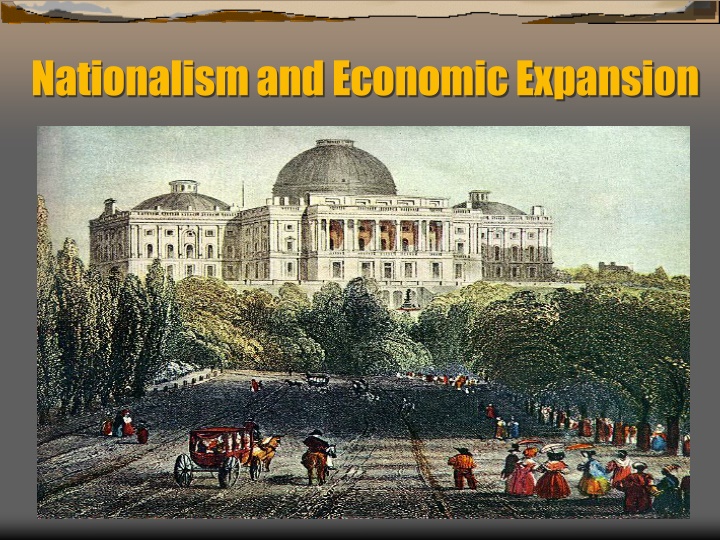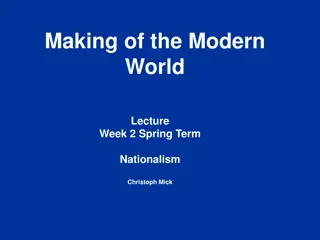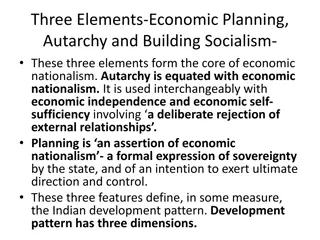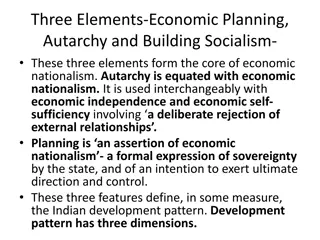Nationalism and Economic Expansion
The images and text provided depict key historical events and figures during the Era of Good Feelings in the United States, highlighting aspects such as economic growth, political stability, and national unity. From President James Monroe to the Missouri Compromise of 1820, the content showcases how nationalism and internal improvements played crucial roles in shaping the nation's development.
Download Presentation

Please find below an Image/Link to download the presentation.
The content on the website is provided AS IS for your information and personal use only. It may not be sold, licensed, or shared on other websites without obtaining consent from the author.If you encounter any issues during the download, it is possible that the publisher has removed the file from their server.
You are allowed to download the files provided on this website for personal or commercial use, subject to the condition that they are used lawfully. All files are the property of their respective owners.
The content on the website is provided AS IS for your information and personal use only. It may not be sold, licensed, or shared on other websites without obtaining consent from the author.
E N D
Presentation Transcript
James Monroe 5thPresident Virginia Democratic- Republican Ran unopposed during the election of 1816 Federalist collapsed after War of 1812 No political struggles for power
Era of Good Feelings NATIONALISM CLAY S AMERICAN SYSTEM Nationalism- pride toward one s country Period characterized by lack of political disruption and economic growth People started shifting loyalty toward the federal government Henry Clay wanted the U.S. to be economically self-sufficient: Established a protective tariff- made foreign goods more expensive Established a national bank- would promote a single currency and make trade easier Improved the country s transportation system
Internal Improvements National Road- stretched from Maryland to Illinois Designed as the countries main east-west route Erie Canal- man-made water route between NYC and Buffalo New York Opened the Ohio River Valley and the Great Lakes to trade and settlement Allowed the flow of manufactured goods from east to west Helped NYC become the nation s largest city
Supreme Courts helps Nationalism McCulloch vs. Maryland Maryland wanted to tax its branch of the national bank If allowed, states could claim power over the national govt Court said NO! Promoted unity by strengthening the federal government Gibbons vs. Ogden Two steamship operators fought over shipping rights between NY and NJ Court ruled that interstate commerce could only be regulated by the federal govt Stronger federal government reflected growing nationalism VS
Missouri Compromise (1820) Missouri applies for statehood Wants slavery to be allowed 11 free and 11 slave states currently Missouri would ruin the balance South would have more power in Congress Maine admitted with Missouri as a free state Maine = free state Missouri = slave state Slavery banned in future territories north of 36 30 Henry Clay led compromise
Use this map to label and color your map. Any 5 colors will do. Fill in the map key as you go. Be sure to color the TERRITORY of Michigan differently than the free STATES. Be sure to color the TERRITORIES of Florida & Arkansas differently than the slave STATES.
Tense relations with Spain Disagreed over boundaries Indians in east Florida raiding Georgia Monroe sent Andrew Jackson to stop raids Jackson ended up claiming Florida Monroe gave Spain a choice: police Florida or give it to us Adams Onis Treaty (1819) Spain gave the U.S. Florida Created new boundary line Spain no longer claimed Oregon Now only claimed by Britain and U.S. Growing National Boundaries
Sectionalism Grows Sectionalism: loyalty to the interests of your own region rather than the country as a whole Economic changes led to different interests and needs among the North, South, and West These interests often were in conflict North- wealth based on manufacturing and trade South- plantation system and cotton West- wanted cheap land and good transportation system
Monroe Doctrine (1823) Latin American colonies gained independence from Spain and Portugal Some European monarchs planned to help them get their colonies back U.S. felt threatened Doctrine stated that: Americas were closed to European colonization U.S. would stay out of European affairs Showed that U.S. considered itself a world power
At the bottom of your notes page Write down the following, leaving space between the lines to write: STOP SIGN LINE OFF LIMITS























